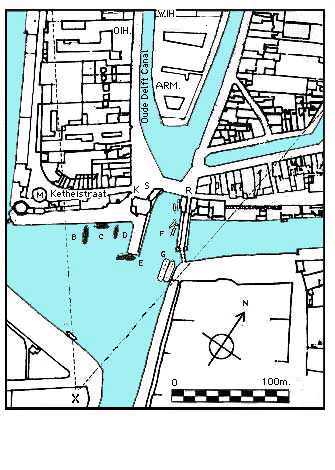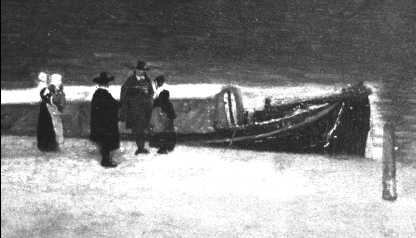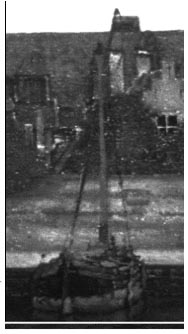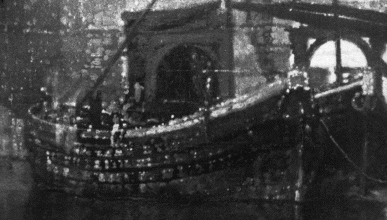 A)
To the left, at the front: a tow barge or tent barge
('trekschuit' or
'tentschuit'), its
entrance and exit opening towards the water, not the shore. At the quay in the far
back we see from left to right:
A)
To the left, at the front: a tow barge or tent barge
('trekschuit' or
'tentschuit'), its
entrance and exit opening towards the water, not the shore. At the quay in the far
back we see from left to right:Kees Kaldenbach, Art Historian
Note. This is an abstract of an article which originally appeared in the Dutch scientific magazine on shipping history,Tijdschrift voor Zeegeschiedenis, March 2000. A full size discussion of this subject in English will appear on this internet page AFTER my study on this subject has been published in an English language magazine. I am afraid until that time this summary will have to do for English readers!
In the View of Delft by Johannes Vermeer, one of the great masterworks of Dutch painting, the harbor or 'Kolk' of Delft and the various ships in it are given a prominent place. This article discusses the various types of ships on this painting and questions whether these ships are shown in a documentary way, adding to our knowledge of the painting.
 A)
To the left, at the front: a tow barge or tent barge
('trekschuit' or
'tentschuit'), its
entrance and exit opening towards the water, not the shore. At the quay in the far
back we see from left to right:
A)
To the left, at the front: a tow barge or tent barge
('trekschuit' or
'tentschuit'), its
entrance and exit opening towards the water, not the shore. At the quay in the far
back we see from left to right:
B) at the far left a Dutch inland sailing ship with a curved stern ("kromsteven") seen from the back, possibly a 'smalschip'. C) ditto, seen from the side. D) ditto, seen from the back.
E) at the head of the dam just in front of the Schiedam gate there is a larger curved stem "kromsteven", possibly a 'wijdtschip', seen from the side, a wijdtschip being defined as wider than 4,68 meter, and possibly being in use for long distance ferrying. See technical drawings ; Wijdtschip from above and Wijdtschip seen from the side
F) At the right side towards the back there is a group of four tow barges ('trekschuiten') similar to the one in front.
G) To the far right, moored at the shipyard, there are two herring busses ("haringbuizen"), ships specifically designed for herring fishery during the hours of darkness.
Map by Kees Kaldenbach.
A) tow barge, technical drawing or 'tent barge seen from above'), its exit opening towards the water, not the shore.
 Tow barge.
Tow barge.
In Delft this type of ship was put into service in 1655 when the line service to Rotterdam was started. Vermeer thus shows us a recent transport innovation in the Delft region.
 "Smal"
ship, on the left side of Vermeer's
painting.
"Smal"
ship, on the left side of Vermeer's
painting.
At the quay in the far back we see from left to right: B) at the far left a curved stem CHECK ('kromsteven') seen from the back, possibly a 'smalschip'. C) ditto, seen from the side. D) ditto, seen from the back. E) at the head of the dam just in front of the Schiedam gate there is a larger curved stem 'kromsteven', possibly a 'wijdtschip', seen from the side, a wijdtschip being defined as wider than 4,68 meter, and possibly being in use for long distance ferrying.
The photo on the right hand side shows the "smalschip" ship indicated as B).
 In the middle of the painting we see a "wijdt" ship which is a
relatively wide interior ship.
In the middle of the painting we see a "wijdt" ship which is a
relatively wide interior ship.
It is a larger type of "kromsteven" defined as 'a Dutch inland sailing ship with curved stern posts'. The rudder pole projected through these stern posts called "hek".
Vermeer depicts a "Wijdt" ship, in the middle, in front of the Schiedam Gate.
Technical drawings ;
see Wijdtschip from above and
Wijdtschip seen from the side .
F) At the right side towards the back there is a group of four tow barges ('trekschuiten') similar to the one in front (see above). See tow barge/ trekschuit, technical drawing or 'tent barge/schuit seen from above'.
 Herring
busses to the far right side, indicated as G)
To the far right, moored at the shipyard, there are two
herring busses ('haringbuizen'), ships
specifically designed for herring fishery during the hours of
darkness.
Herring
busses to the far right side, indicated as G)
To the far right, moored at the shipyard, there are two
herring busses ('haringbuizen'), ships
specifically designed for herring fishery during the hours of
darkness.

ARM) Armamentarium, an arsenal in which however no gunpowder was kept.
OIH) East India House (Oost-Indisch Huis), head quarter of the Delft Chamber of the Dutch East India Company (VOCD)
OIP) East India Warehouse (Oost-Indisch Pakhuis) of the VOCD
WIH) Warehouse of the West India House
M) A windmill.
X) Standpoint chosen by Vermeer on the first floor of a house which may be seen on maps of his era.
Analysis leading to an exact dating
In my detailed Dutch language article in the Tijdschrift voor Zeegeschiedenis each type of ship is discussed as to its depiction, shape, size and uses. Information is given on the tow barges as most archival documents deal with their rules and regulations from 1655 onwards. Research and literature is mentioned in notes. The article discusses all of these types of ships and finally proposes a precise dating for the scene of Vermeer's painting 'View of Delft'. The dating is analyzed by this step by step method.
Each year the active season of the herring busses was limited by law from June 1st to the end of December. Herring busses were costly investments. These ships were used optimally during that legal fishery season. These two ships are however far away from their regular harbour of Delfshaven and are clearly under repair, missing a few masts and being otherwise empty, floating extremely high on the water. This in turn indicates an early season for the total scene. Given the orientation of the scene, the full green foliage and the active maintenance works on these two ships which are moored at the Delft shipyard - getting ready before June 1st - it follows that the intended scene and/or the actual conception of this painting must be dated at an early morning in the first half of May.
Of which year? Because of conflicting evidence one cannot tell for sure whether there were bells visible in the tower of the New Church up until 1660. The delivery by the Hemony firm of the carillon of the New Church tower started in 1660 by hoisting down existing bells of the New Church tower to a shed at ground level. All bells were hoisted up again late in the summer of 1661. Vermeer clearly shows an empty bell tower in his painting. This supports the dating in 1660-1661, a period being previously suggested on the basis of Vermeer's stylistic development. Thus we are watching a scene during an early morning in the first half of May 1660 or 1661. As Vermeer worked slowly and meticulously (and newer paint layers have filled "premature drying cracks" in older layers) the painting may have been finished somewhere around 1662 to 1665 when he will have delivered it to his maecenas, art collector Pieter Claesz van Ruijven and his wife Maria de Knuyt - see Map of Delft with artists and patrons.
Afterword. The scheduled traffic by long-haul ship and tow barge was not only a first class technical accomplishment, but it also influenced communication within society. In a ship or tow barge people sat for quite a while and a meeting of minds took place between men and women from town and countryside. Contact also occurred between people who were of quite different social sphere, religion and political persuation. A new kind of pamphlet appeared on this subject: the tow barge talk ('schuitepraatje' ) with current discussions on various subjects.
One day, while sitting in a tow barge, David Beck who was a schoolteacher and amateur painter living in the town of The Hague, got into a conversation with a fellow passenger, cabinet maker Master Anthonie. The subject between the two of them was fine art. Normally Beck during travels was used to read for an hour in a favourite book of his, Van Mander's Schilder-bouck. Source: S.E. Veldhuizen (ed.) David Beck, Spiegel van mijn leven, een dagboek uit 1624. Hilversum, 1993 p.82 and 54.
Send me an E-mail ? kalden@xs4all.nl.
Text copyright Kees Kaldenbach. Illustration copyright Mauritshuis Den Haag, Nederlands Scheepvaartmuseum Amsterdam ; map design by Kees Kaldenbach, Amsterdam. These illustratons may not be re-published without written permission of the museums.
Launched 5 May 2000, last update March 30, 2011.